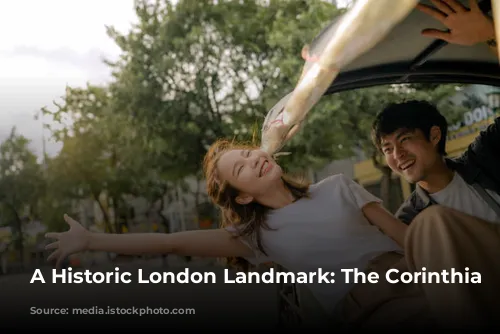Standing tall in the heart of London, at the intersection of Northumberland Avenue and Whitehall Place, the Corinthia Hotel boasts a rich history intertwined with the city’s political and cultural fabric. Initially known as the Metropole Hotel, its grand opening in 1885 marked a significant moment. This luxurious establishment was strategically positioned close to the Palace of Westminster and the government offices in Whitehall, making it a hub for the city’s elite.
The hotel’s strategic location, however, made it a target for requisition during both World Wars. Its doors were opened to house government staff, serving as a vital resource for the war effort. After the Second World War, it was purchased by the Ministry of Defence and transformed into government offices. But fate had other plans for this iconic structure. In 2007, after being deemed surplus to requirements, it was sold by Crown Estates and embarked on a journey of restoration and rebirth.
A Century of Glamour and Royalty
The Metropole Hotel quickly became a prominent venue for London’s social scene. The Aero Club and the Alpine Club held their annual dinners within its walls, while the first London to Brighton run in 1896 saw competitors gather at the hotel before embarking on their journey. Even the Prince of Wales, later known as King Edward VII, was a frequent guest, with a reserved box in the ballroom and a lavish Royal Suite reserved for his exclusive use.
The hotel continued to thrive as a social hub, hosting the renowned “Midnight Follies” cabaret, a spectacle that captivated the city’s night owls. In 1921, a young musician named Bert Firman joined the “Midnight Follies” orchestra, and at the age of sixteen, he became the youngest bandleader in the world, leading the hotel’s orchestra through the roaring twenties.
A Tapestry of Sporting Legends and Political Power
The Metropole Hotel was not only a haven for the elite but also witnessed historical sporting moments. In 1936, England’s rugby team secured a legendary victory against the touring New Zealand All Blacks, with a historic performance by Prince Alexander Obolensky, who scored three tries and etched his name in the annals of rugby history.
However, the hotel’s fate took a dramatic turn in the mid-1930s when the government decided to redevelop the surrounding buildings. In 1936, the entire hotel was leased for £300,000pa, becoming a temporary home for various government departments, including the Ministry of Labour, the Ministry of Transport, the Air Ministry, and the Ministry of Defence.
As the clouds of war gathered once again, the government extended the lease, utilizing the hotel to house vital departments, including MI9, the Special Operations Executive, and even serving as a planning center for the Operation Overlord. This historical building, once a symbol of luxury, became a crucial nerve center for the war effort, showcasing its resilience and adaptability in the face of adversity.

From Government Hub to Luxury Hotel
After the war, the Metropole Hotel was purchased by Gordon Hotels and transferred to the Crown Estate portfolio. The Ministry of Defence continued to use the building as its headquarters, housing crucial departments like the Defence Intelligence Staff. Even in the popular James Bond comic strip, the Metropole Building was often depicted as the MI6 HQ, solidifying its association with espionage and intrigue.
In 2007, the Metropole Building and its adjoining property, 10 Whitehall Place, were acquired by a consortium led by Malta’s IHI plc, marking a turning point in the hotel’s destiny. After extensive renovations, the building reopened its doors in 2011 as the Corinthia Hotel, a luxurious blend of hotel and residential complex, with 10 Whitehall Place transformed into twelve residences and a spa. The hotel’s reopening was a testament to its enduring spirit, showcasing its ability to evolve with the times while honoring its rich past.

A Modern Icon with a Historic Soul
The Corinthia Hotel continues to embrace its history, paying homage to its past by hosting events that connect the hotel’s rich history with modern pop culture. The official announcement of the James Bond film Skyfall was held at the hotel in 2011, further cementing its connection with the world of espionage. In 2018, scenes from the thriller Red Sparrow were filmed both inside and outside the hotel, highlighting its cinematic appeal and ability to captivate audiences.
Today, the Corinthia Hotel stands as a testament to the city’s enduring spirit, a luxurious sanctuary where history and modernity seamlessly intertwine. Its illustrious past, marked by royalty, wartime service, and cultural milestones, continues to inspire and resonate with visitors from all corners of the globe. As you step into this magnificent hotel, you are not simply entering a building; you are stepping into a time capsule, a living testament to London’s remarkable history.










